Using Earned Value Management Indexes as a Team Development Factor and a Compensation Tool
Publications
IPMA – International Project Management Association Global Congress
New Delhi – India – 2005
PMI Global Congress 2004 – EMEA
Prague – Czech Republic – 2004
Abstract
The objective of this paper is to present the main components of the development of a project team, the motivational characteristics inherent to the team work and an interrelation proposal between the earned value analysis and team development through the SPI and CPI indexes obtained by the tool and team development models and the compensation and reward in the project, allowing to reduce the evaluation subjectiveness of the human resource in the project.
The paper presents a brief report about the team development and compensation policies, as well as an introduction to the earned value concept aiming to align the approached concepts.
Team Development in Projects
The project human resources area is one of the PMBOK Guide 2000 (PMI 2000) knowledge areas that the manager and project team have requested more attention.
As reported in the Guide, the Project Human Resources Management includes the processes required to make the most effective use of human resources involved with the project. It includes all project stakeholders: sponsors, customers, individual contributors and others. The main processes are described below and Exhibit 1 provides an overview of the processes according to each project phase.
Organizational Planning – identify, document and assign project roles, responsibilities and the reporting relationships.
Staff Acquisition – make the required human resources be designed and work in the project.
Team Development – develop individual and group skills to increase project performance.

Exhibit 1 – Human Resources Management Processes distributed throughout the project phases.
These processes interact with each other and with the process in the other knowledge areas. Each process may involve effort from one or more individuals or groups depending on the needs of the project.
The team development approached in this paper involves the increase of the capability of the involved parties to contribute individually, as well as the increase of people capability to work as a team. The individual growth (managerial and technical) is the basis required to develop the team becoming it crucial to the success of the projects and, therefore, becoming the key for the organization to accomplish their goals.
According to FITZ-ENZ (2000), each organization and each project are led by a combination of strengths and internal and external factors. These factors are the ones that make the organization unique, describing collectively how and why the organizational processes influence on the performance improvement. The internal factors are the ones determined by the own organization and project goals, while the external objectives are those determined by external business environment in which the company and projects are inserted (Exhibit 2).
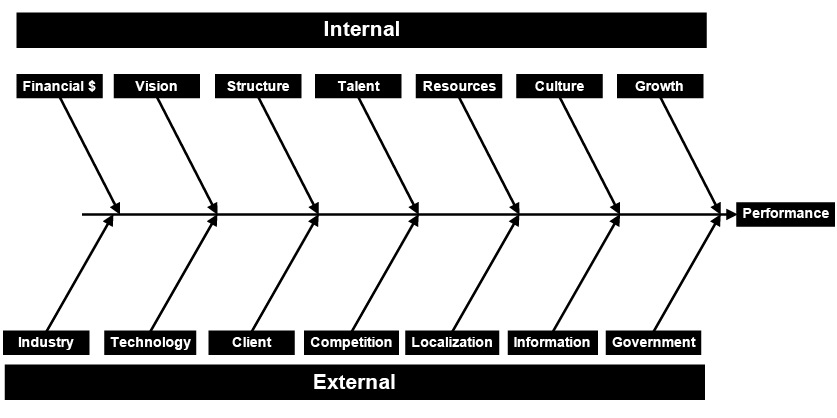
Exhibit 2 – Performance change factors
According to FLANES & LEVIN (2001) performance problems that impede the team members to perform their activities successfully can be divided in:
- Problems related to technical competency
- Problems related to relationship and communication
- Problems related to time management and work habits
Due to the above problems, it is fundamental to have an impartial and objective performance evaluation process that besides addressing the mentioned problems, it allows improvements in the individual skills, improvements in the team behavior and improvements not only in the individual competencies but also in the team ones.
This impartial model directly reduces the subjectiveness of the performance evaluation and increases the team motivation according to the Adam’s Equity Theory (VERMA, 1995), as people get motivated when they are treated in equity, impartial and fair way.
Professional compensation (Reward)
Some of the main tools available to increase performance are the compensation and reward policies that according to PMI (2000) are the formal actions that promote or reinforce desired behavior. To be effective, such system should make the link between performance and reward clear, explicit and achievable.
According to PARKER, MCADAMS & ZIELINSKI (2000) the reward models are designed to create a focus on specific goals or celebrate and reward individuals or teams with diversified performance. To them, the reward models should meet individual, team and organization needs, according to the model showed in Exhibit 3.
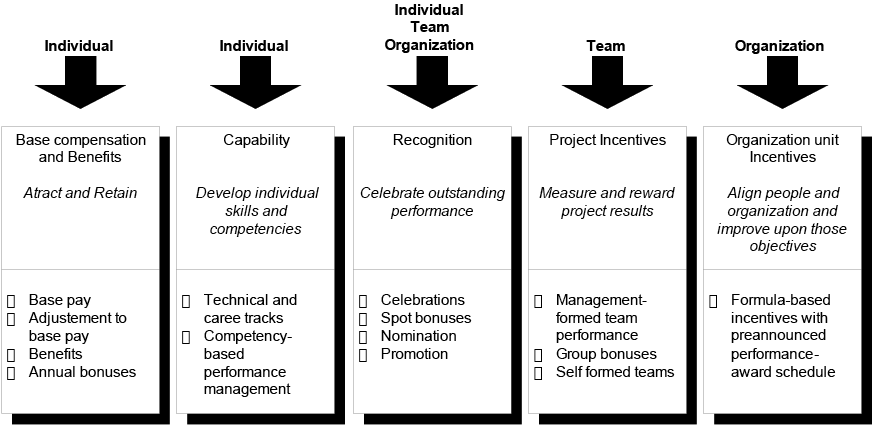
Exhibit 3 – Reward policies and bonuses (PARKER, MCADAMS e ZIELINSKI, 2000)
To SHUSTER (2000) the bonuses always need to satisfy the individual and the team. If a team satisfaction is neglected to satisfy an isolated individual, this process naturally generates dissatisfaction and demotivation. Thus, higher reward can only be gotten when high team and individual performances are achieved, as per Exhibit 4.
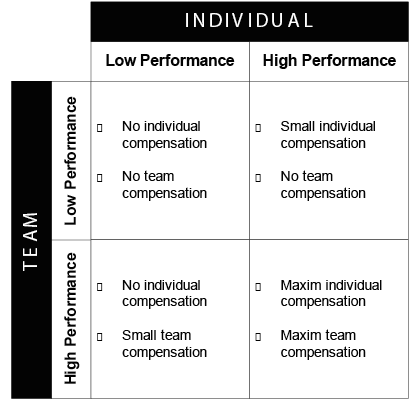
Exhibit 4 – Team and individual performance extent (Based on Shuster, 2000)
Earned Value Analysis
Earned value is focused on the relation between incurred actual cots and the work performed in the project in a given time period. The focus is on performance obtained in comparison to what was spent to get it. (FLEMING & KOPPELMAN, 1999).
Earned value is the evaluation between what was actually spent and what was budgeted, proposing that the value to be earned initially by an activity is the value budgeted for it. As each activity or task of a project is performed, the initial budgeted value for the activity starts to constitute now the Earned Value of the project.
In order to formalize the mentioned concepts based on instruction DOD (1997) and on norm ANSI/EIA 748 of the American National Standards Institute, a specific terminology was created based on forecasted and actual costs, as well earned value. The basic three elements of the earned value analysis are:
BCWS (Budget cost of work scheduled) is the value that indicates the budget portion that should be spent, taking into account the activity budget base line cost, allocation or resource. BCWS is calculated as budget base line cost divided into phases and cumulative up to the status date, or current date. It is the budgeted cost.
BCWP (Budget cost of work performed) is the value that indicates the budget portion that should be spent, taking into account the work performed up to the moment and budget base line cost for the activity, allocation or resource. BCWP is also called Earned Value.
ACWP (Actual cost of work performed) value that shows actual costs incurred from the work already performed by a resource or task up to the status date or project current date from financial inputs.
Once these three parameters are determined, the outcome analysis is obtained based on the correlation between values found for each one in a given status date (Exhibit 5).
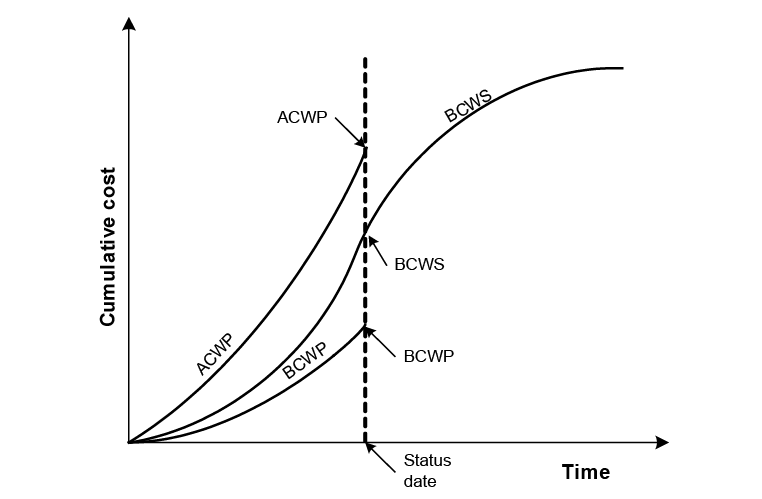
Exhibit 5 – BCWS, BCWP e ACWP graphic example throughout the time for a given project
The correlation among BCWS, BCWP and ACWP values allows to rate project outcomes and to proceed evaluations and future final cost forecasts.
To treat the ratio among BCWP and BCWS and ACWP parameters, there are the following indexes:
A) SPI (Schedule Performance Index) – Division between the Earned Value (BCWP) and the budgeted base line cost (BCWS). SPI shows the conversion rate of the budgeted value in the Earned value.

SPI equals 1 indicate that the budgeted value was completely earned to the project. SPI lower than 1 indicates that the project is being performed at a conversion rate lower than scheduled, that is, the financial amount scheduled to be earned in the period was not achieved and the project is late. SPI higher than 1 indicates that the project is earning outcomes in a speed higher than scheduled, i.e., it is advanced.
B) CPI (Cost Performance Index) – Division between the Earned Value (BCWP) and the actual cost and (ACWP). CPI shows the conversion between the actual values spent by the project and the earned values in the same period.

CPI equals 1 indicate that the value spent by the project was completely earned to the project (project in the budget). CPI lower than 1 indicates that the project is spending more than scheduled up to the moment. If CPI is higher than 1 indicates that the project is costing less than scheduled up to that moment.
Human Performance Index and Professional Evaluation Models
In order to allow the team evaluation ad project professional it was developed a new index called Human Performance Index (HPI). This index consists of the relationship between the CPI and SPI allowing the creation of an index that evaluates the accomplishment of the schedule and budget of the activities executed by the resource simultaneously.
In developing this paper, it was studied several types of relationship between indexes (sum, average, product, etc.), however, as the nature of the two indexes differs from the complete percentage of the project, it was chosen the composition of the indexes with complete percentage, where the participation of schedule performance index in the beginning of the project is higher than the cost performance index, while at the end of project occurs an inversion in the participation of indexes, once the SPI tends to 1 (BCWP

BCWS) with the termination of the project.
The resulting formula is

Where CPI = Cost performance index
SPI = Schedule performance index
%C = Project complete physical percentage
Exhibit 6 observes it the participation of the indexes in the HPI composition along the project.

Exhibit 6 – Participation of the indexes according to project complete percentage
From the creation of this index, it is required to evaluate the HPI´s not only the individual work outcome but also the team work in which the resource is integral part of the project as a whole, creating a final HPI that is the weighed average of these three indexes as it is presented below:

Where CPIIndividual = Cost performance index of the work packages where the evaluated resource was involved
SPIIndividual = Scheduled performance index of the work packages where the evaluated resource was involved
CPITeam = Cost performance index of the team work packages of which the evaluated resource is participant
SPITeam = Schedule performance index of the team work packages of which the evaluated resource is participant
CPIProject = Cost performance index of the project
SPIProject = Schedule performance index of the project
WeightIndividual = Contribution of resource HPI in the HPIFinal
WeightTeam = Contribution of team HPI in the HPIFinal
WeightProject = Contribution of project HPI in the HPIFinal
%C = Project complete physical percentage
HPIFinal can be obtained from different strategies starting from a strong focus on individual outcomes up to a balanced focus among the individual, team and project. Follows a model of weight composition for different focuses

Exhibit 7 – Example of a proposal of weight distribution for the HPI resource composition
It is important to emphasize that the resource, team and project HPI´s are not obtained from CPI and SPI´s work packages, but from the sum of the BCWS, BCWP and ACWP’s resource activities and later from the formula application, CPI=BCWP/ACWP and SPI = BCWP/BCWS.
Example
In order to illustrate the index development it has a project composed of twenty different work packages to be performed by five resources in two teams. The resources 1, 2 and 3 belong to Team A and the resources 4 and 5 to Team B, respectively. In Exhibit 8 there is the distribution of the resources in the work packages.
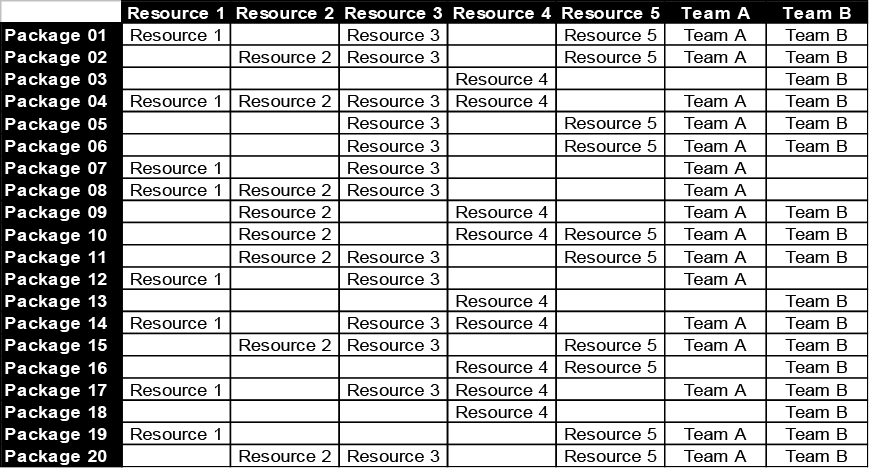
Exhibit 8 – Resource distribution to be used in the work packages
In a given moment of the project the package performance inputs were evaluated, obtaining the figure 9 with BCWS, BCWP and ACWP inputs for each work package
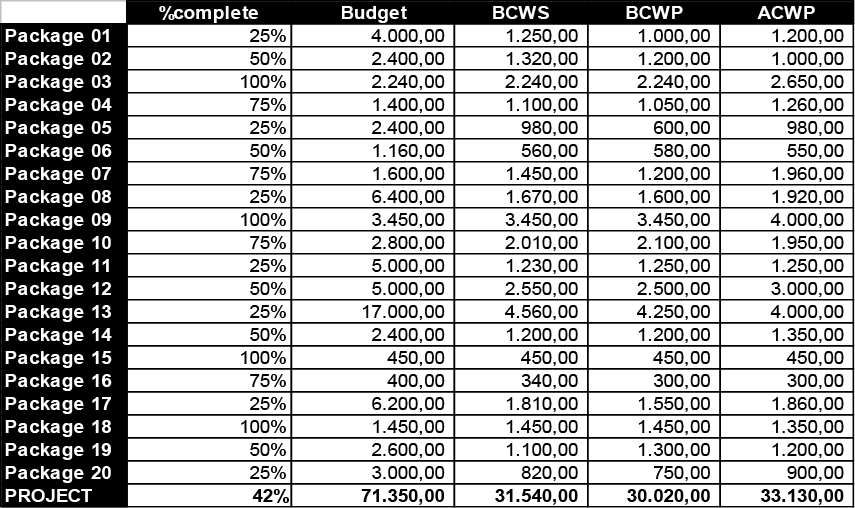
Exhibit 9 – Example of data collected for a project with determined BCWS, BCWP and ACWP
From the overcome crossing of each package with resources used in them, it was obtained the HPI of each one of the resources, as well as the HPI of each one of the teams and the total HPI of the project according to Exhibit 10.

Exhibit 10 – Project and resource HPI outcomes
Observing that each resource belongs to a given team, there are the following individual results, shown in exhibit 11.

Exhibit 11 – HPI results of each resource
From the combination of the results of exhibit 11 with the ones of exhibit 7, there are the final HPI of each resource from the individual, team and project focus and the balance focus among the three parameters, obtaining the exhibit 12.

Exhibit 12 – HPI results of each resource
From these values it can be analyzed the outcomes of each one of the resources and its contribution for the project and team outcome, as per example, it is shown in the exhibit 13.
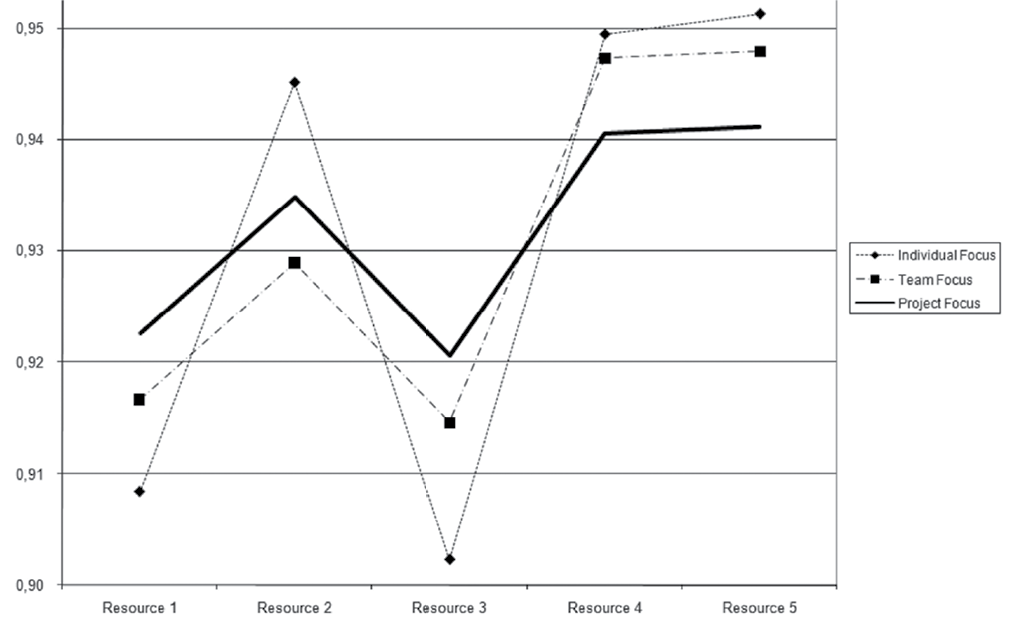
Exhibit 13 – Comparative graphic of the focuses among the individual, team and project for the 5 evaluated resources
In this example, it is observed that the resources 1 and 3 showed a performance lower than their team and project; the resource 2 showed a higher individual performance, however, in analyzing its team, its performance was damaged by weak performance of resources 1 and 3. Resources 4 and 5, they had high performance, increasing this way the performance of Team B. The project performance was lower than the 4 and 5 resources performance and Team B because the members of Team A lowered the global performance by their weak individual performances.
Conclusions
The main objective of this paper was to present an evaluation proposal of the human resources and teams through more direct mathematical model than the subjective evaluation by the project manager. Besides, bonuses and reward policies may be directly connected to the indexes causing more transparent mechanism of the distribution of project outcomes
However, some cautions have to be taken in using this kind of evaluation. First, when the executer is not the responsible for the budget accomplishment, he/she can have his/her performance compromised by weak performance of the procurement team, as an example. Secondly, this mathematical model may not be deterministic, i.e., the only one to represent the truth of the work outcome of the project resource, once they are completely mathematical, they may not evidence subjective human aspects inside the team work.
References
DOD (1997). Earned value Management Implementation Guide. Washington: United States of America Department of Defense
FITZ-ENZ, J. (2000). The ROI of Human Capital: Measuring the Economic Value of Employee Performance. New York; AMACOM.
FLANES, S. W. & LEVIN, G. (2001). People Skills for Project Managers. Vienna: Management Concepts.
FLEMING, Q. W. & KOPPELMAN, J. M. (1999). Earned value Project Management, 2nd Ed. Newton Square: Project Management Institute.
PARKER, G., MCADAMS, J. & ZIELINSKI, D. (2000). Rewarding Teams: Lesson from the Trenches. San Francisco: Jossey-Bass.
PMI (2000). A guide to the Project Management Body of Knowledge. Newton Square: Project Management Institute.
SHUSTER, H. D. (2000). Teaming for Quality: The Right Way for the Right Reason. Newton Square: Project Management Institute.
VERMA, V. K. (1995). Human Resource Skills for the Project Manager vol. 2. Upper Darby: Project Management Institute.
Earned Value